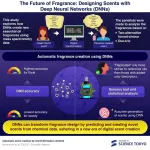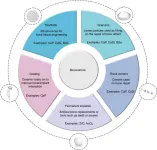(Press-News.org) Leuven, 2 January 2024 – Researchers from the lab of Prof. Sarah-Maria Fendt (VIB-KU Leuven) and colleagues have uncovered that the availability of the amino acid aspartate is one reason why the lung is a frequent organ of metastasis. Their work appears in Nature and improves our understanding of cancer biology while providing the foundation for new therapeutic interventions in metastatic diseases.
A role for aspartate
More than half of cancer patients in whom the cancer spreads beyond the primary site have lung metastases. What makes the lungs such a tempting place for cancer cells?
To find out, the team of Prof. Sarah-Maria Fendt (VIB-KU Leuven Center for Cancer Biology) and colleagues investigated the gene expression in cells from aggressive lung metastases. They found evidence for an alternative ‘translation program.’ What does this mean? Translation is the process that uses our genetic code as a blueprint to make proteins in cells. A change in the translational program results in a set of different proteins that allow cancer cells to grow easier in the lung environment.
But what starts this alternative translational program in aggressive metastases?
Ginevra Doglioni, PhD student at the Fendt lab and first author of the study says “We found high levels of aspartate in the lungs of mice and patients with breast cancer compared to mice and patients without cancer, which suggests that aspartate may be important for lung metastasis”
Aspartate is an amino acid (a protein building block) that has very low concentrations in blood plasma but, surprisingly, very high concentrations in the lungs of mice with metastatic breast cancer.
Starting the translational program
Many proteins in our bodies can affect the translation process, among them the so-called initiation factors. One such initiation factor is eIF5A, which kickstarts translation. In the cells of cancer cells within lung metastases, the researchers found an activating modification to eIF5A called ‘hypusination’, which was associated with higher cancer aggressiveness of lung metastases.
Does aspartate have something to do with this?
Yes, it does! The researchers discovered that aspartate triggered this modification on eIF5A through an unexpected mechanism. Surprisingly, aspartate was not taken up by the cancer cells. Instead, it activated a cell surface protein called an NMDA receptor in cancer cells, leading to a signaling cascade that, eventually, triggered eIF5A hypusination. This subsequently drives a translational program that enhances the ability of cancer cells to change their environment and make it more suitable for aggressive growth.
Looking at human lung tumor samples from patients with metastatic breast cancer, the scientists noted a similar translational program as in mice and an elevated expression of the NMDA receptor subunit that binds aspartate compared to metastases from other organs.
Prof. Fendt explains, “This correlation emphasizes the relevance of the findings in a clinical context and suggests that aspartate signaling may be a common feature of cancer cells growing in the lung. Moreover, there are drugs available to target the mechanism we identified and thus with further research a translation toward a clinical setting might be possible.”
Funding
This research was supported by FWO, Kom Op Tegen Kanker, Stichting tegen Kanker, Beug Foundation, King Baudouin Foundation, Fonds Baillet Latour, Francqui Stichting, Foundation ARC, and KU Leuven.
END
Researchers reveal why the lung is a frequent site of cancer metastasis
The amino acid aspartate is one reason why the lung is a frequent organ of metastasis.
2025-01-01
ELSE PRESS RELEASES FROM THIS DATE:
Aging may change some brain cells more than others
2025-01-01
EMBARGOED FOR RELEASE: Jan. 1, 2025, 11 a.m. ET
CONTACT:
NIAPressTeam@mail.nih.gov, 301-496-1752
Aging may change some brain cells more than others
NIH-funded mouse study provides roadmap for how aging may alter brain cell genetic activity
Based on new brain mapping research funded by the National Institutes of Health (NIH), scientists have discovered that not all cell types in the brain age in the same way. They found that some cells, such as a small group of hormone-controlling cells, may undergo more age-related changes in genetic activity than others. The results, published ...
Special issue of APA’s official journal focuses on psychedelic medication
2025-01-01
WASHINGTON, D.C., Jan. 1, 2025—As the body of research grows around the potential promise of psychedelic medications in psychiatry, many questions and challenges remain. The January issue of the American Journal of Psychiatry features a series of articles, including new research, reviews and commentaries, on the use of these treatments.
The issue addresses many of the ongoing challenges and looming questions in the field of psychiatric psychedelic research and treatment. These include issues relevant to basic ...
Geneticist unlocks mysteries of childhood psychiatric disorders through innovative research
2024-12-31
TORONTO, Ontario, Canada, 31 December 2024 - In a comprehensive Genomic Press Interview, leading geneticist Dr. Cathy Barr unveils crucial discoveries about the complex interplay between genes and childhood psychiatric disorders. As a Senior Scientist at both the Hospital for Sick Children and Krembil Research Institute, Dr. Barr's research illuminates the genetic foundations of conditions including depression, attention-deficit/hyperactivity disorder, reading disabilities, and Tourette syndrome.
"After decades of searching ...
New study uncovers key insights into protein interactions in Duchenne muscular dystrophy, paving way for more targeted therapies
2024-12-31
AURORA, Colo. (Dec. 31, 2024) – A groundbreaking study has shed light on the complex interactions between dystrophin, a protein critical to muscle stability, and its partner protein, dystrobrevin, offering new pathways for understanding and treating Duchenne Muscular Dystrophy (DMD).
Published in the December issue of the Journal of Biological Chemistry, researchers characterize the mysterious C-terminal (CT) domain of dystrophin and its role in stabilizing cellular membranes across various tissues.
DMD, a severe genetic disorder that causes muscle weakness and shortens lifespans, arises from mutations in the gene encoding ...
Revolutionizing fragrance design using deep neural networks (DNNs) scent profiles from chemical data
2024-12-31
Scientific research explores the potential of DNNs in transforming fragrance design. By analyzing the sensing data of 180 essential oils, the DNN was trained using the odor descriptor data from 94 essential oils to generate fragrance profiles, validated through sensory evaluations to align with human olfactory perceptions. The study underscores the technological ability to streamline fragrance creation, reduce costs, and foster innovation, opening up exciting possibilities for personalized and scalable scent development.
Deep Neural Networks (DNNs) have become an essential driver of innovation across various industries, ...
Custom-fit bone grafts: the future of craniomaxillofacial surgery
2024-12-31
A recent review is transforming the landscape of craniomaxillofacial bone regeneration with the introduction of personalized bioceramic grafts. This pioneering research explores the fabrication and clinical potential of synthetic grafts created through additive manufacturing (AM), addressing key limitations of traditional autogenous grafts. By focusing on 3D-printed bioceramics tailored to meet individual patient needs, the study marks a significant advancement in both precision medicine and patient-specific care, offering new hope for those requiring bone reconstruction.
Craniofacial bone defects, resulting from trauma, congenital conditions, or surgical ...
A new ‘molecular lantern’ detects brain metastasis in mice by inserting a probe thinner than a hair into the brain
2024-12-31
Monitoring the changes caused in the brain at the molecular level by cancer and other neurological pathologies in a non-invasive way is one of the great challenges of biomedical research. A new technique, still in the experimental stage, achieves this by introducing light into the brains of mice using a very thin probe. The innovation, which is published today in the journal Nature Methods, is ledby an international team including groups from the Spanish National Research Council (CSIC) and the Spanish National Cancer Research ...
McGill scientist reveals how early life experiences reshape our genes and brain health
2024-12-31
MONTREAL, Quebec, Canada, 31 December 2024 - In a comprehensive Genomic Press Interview, renowned neuroscientist Dr. Michael Meaney reveals pivotal discoveries about the intricate relationship between genes and environment in shaping brain health. As a James McGill Professor Emeritus and former Director of the Translational Neuroscience program at ASTAR Singapore, Dr. Meaney's research has fundamentally altered our understanding of how early-life experiences influence genetic expression and brain development.
"I have always been genuinely fascinated ...
Renowned scientist reveals vital link between inflammation and depression through groundbreaking research
2024-12-31
JERUSALEM, Israel, 31 December 2024 - In a comprehensive Genomic Press Interview, distinguished neuroscientist Professor Raz Yirmiya unveils transformative insights into the relationship between inflammation and depression. As head of the Laboratory for Psychoneuroimmunology at the Hebrew University of Jerusalem, Professor Yirmiya's work has fundamentally changed our understanding of depression's biological underpinnings.
"Most depressed patients do not have any overt inflammatory disease. However, we and others found that exposure to stress, which is the most significant trigger of depression in humans and animals, also ...
Medical researcher explores economic impact of psychedelic therapy implementation
2024-12-31
ATLANTA, Georgia, USA, 31 December 2024 - In a comprehensive Genomic Press Interview, Emory University MD candidate Fayzan Rab shares insights into his pioneering research on the economic and public health implications of psychedelic therapy implementation. Rab's work at the Emory Center for Psychedelics and Spirituality bridges the gap between clinical research and real-world healthcare delivery systems.
"It would be a fool's errand to say that psychedelic therapies alone would change that," says Rab, discussing mental healthcare challenges. "Treating mental illness will require changes within clinical practice but also investments into social safety ...
LAST 30 PRESS RELEASES:
Chicago health information leader recognized for raising CPR readiness and blood pressure awareness
The Intimate Animal, a new book from Kinsey Institute Executive Director Dr. Justin Garcia
When blue-collar workers lose union protection, they try self-employment
New video dataset to advance AI for health care
MEA-based graph deviation network for early autism syndrome signatures in human forebrain organoids
New modeling approach sheds light on rare gut disease
Study documents potentially hazardous flame retardants in firefighter gear
Can certain bacteria regulate aging of the immune system and its related alterations?
AI model helps diagnose often undetected heart disease from simple EKG
There are fewer online trolls than people think
Cell membrane fluctuations produce electricity
Jeonbuk National University study shows positive parenting can protect adolescents against self-harm
Surface-engineered ZnO nanocrystals to tackle perfluoroalkyl substance contamination
This new understanding of T cell receptors may improve cancer immunotherapies
A new fossil face sheds light on early migrations of ancient human ancestor
A new immunotherapy approach could work for many types of cancer
A new way to diagnose deadly lung infections and save lives
40 percent of MRI signals do not correspond to actual brain activity
How brain-inspired algorithms could drive down AI energy costs
Gum disease may be linked to plaque buildup in arteries, higher risk of major CVD events
Contrails are a major driver of aviation’s climate impact
Structure of dopamine-releasing neurons relates to the type of circuits they form for smell-processing
Reducing social isolation protects the brain in later life
Keeping the heart healthy increases longevity even after cancer
Young adults commonly mix cannabis with nicotine and tobacco
Comprehensive review illuminates tau protein's dual nature in brain health, disease, and emerging psychiatric connections
Book prepares K-12 leaders for the next public health crisis
Storms in the Southern Ocean mitigates global warming
Seals on the move: Research reveals key data for offshore development and international ecology
Sports injuries sustained during your period might be more severe
[Press-News.org] Researchers reveal why the lung is a frequent site of cancer metastasisThe amino acid aspartate is one reason why the lung is a frequent organ of metastasis.






